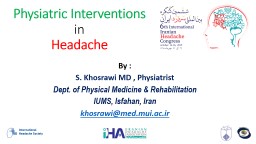

in Headache By S Khosrawi MD Physiatrist Dept of Physical Medicine amp Rehabilitation IUMS Isfahan Iran khosrawimedmuiacir Main rehabilitative goal in headache management سر درد ID: 1009788
Download Presentation The PPT/PDF document "Physiatric Interventions" is the property of its rightful owner. Permission is granted to download and print the materials on this web site for personal, non-commercial use only, and to display it on your personal computer provided you do not modify the materials and that you retain all copyright notices contained in the materials. By downloading content from our website, you accept the terms of this agreement.
1.
2. Physiatric Interventions in Headache By :S. Khosrawi MD , Physiatrist Dept. of Physical Medicine & RehabilitationIUMS, Isfahan, Irankhosrawi@med.mui.ac.ir
3. Main rehabilitative goal in headache managementسر درد درد سر
4. The three major primary headache disorders are : migraine, cluster, and tension.Headache treatment consists of :pharmacologic & non-pharmacologic methods including lifestyle changes as preventive measures.
5. Basics of Non-Drug Treatment Learn appropriate prevention and treatmentReduce triggers :foods, drugs, activities, smoking,…Normalize sleeping and eatingAvoid frequent abortive treatment Physical therapy:(short term and focus on exercise rather than on modalities)Treat postural dysfunction and myofascial pain Reduce spasm (biofeedback, …)Exercise (relaxation , aerobic ,…) Behavioral & Psychotherapy Advanced procedures
6. Migraine HeadacheLifestyle modifications :Regular and adequate sleep and hydrationRegular relaxation & aerobic exercise (Recent studies suggest that moderate intensity aerobic exercise 30-40 minutes 3-5 times/week is as effective as topiramate and relaxation training).Migraine trigger avoidance :Any stressful event, caffeine overuse or withdrawal, missed meals, alcohol, smoking, odors, ?? chocolate or dairy products, processed meats, obesity, …
7. Non-pharmacologic treatment :cognitive-behavioral therapybiofeedback-assisted relaxationacupuncture ?? (weak evidence)physical therapy ? Onabotulinum toxin type A injections into the pericranial musculature received FDA approval for treatment of chronic migraines in 2010.Transcutaneous supraorbital nerve stimulation (t-SNS) , transcranial magnetic stimulation (TcMS) and caloric vestibular stimulation (CVS) have received clearance from FDA.Migraine Headache
8. e-TNS (External Trigeminal Nerve Stimulation) s-TNS (Supraorbital Transcutaneous Nerve Stimulation)FDA clearanceMigraine
9. Transcranial Magnetic Stimulation (TcMS)FDA clearanceMigraine
10. Caloric Vestibular Stimulation (CVS)FDA clearance Migraine
11. Cluster HeadacheLifestyle modification : alcohol avoidance and stress reduction.Non-pharmacologic therapy : 100% oxygen (12-15 L/min. at headache onset by non-rebreather mask for at least 20 minutes aborts headache in 80% of patients)Vagus nerve stimulation (FDA approval for acute episodic cluster)In cases of refractory cluster headache:neuromodulation (sphenopalatine ganglion stimulation ) or ablative surgical procedures on the 5th. cranial nerve (radiofrequency, cryotherapy, and alcohol techniques)
12. Vagus Transcutaneous Nerve Stimulator (v-TNS)FDA approval Cluster
13. Sphenopalatine ganglion microstimulatorCluster
14. Tension HeadacheLifestyle modification :Regular and adequate sleep and aerobic exerciseNon-pharmacologic therapy: Biofeedback (thermal or electromyographic)Physical therapy
15. Electromyographic BiofeedbackTension
16. Occipital NeuralgiaSynonyms: Cervicogenic headacheOccipital headacheOccipital neuropathyOccipital neuritisOccipital myalgia-neuralgia syndromeCervical migraineArnold neuralgia
17. The International Headache Society categorizes occipital neuralgia as a cranial neuralgia and defines it with three diagnostic features: 1*paroxysmal lancinating, sharp pain in the distribution of the occipital nerves2*tenderness over the affected nerves3*temporarily relieved by local anesthetic block
18. Pain provokers : exposure to cold is a common trigger sensory triggers to the face or skull e.g. brushing the hair or moving the neck pressure of the head on a pillow prolonged abnormal fixed postures that occur in reading or sleeping positions and hyperextension or rotation of the head to the involved side, …
19. In chronic continuous occipital neuralgia, the patient may experience spasm & painful attacks that last for days to weeks. On occasion, patients may report other autonomic symptoms concurrently, such as nausea, vomiting, photophobia, diplopia, ocular and nasal congestion, tinnitus, and vertigo.On examination, pain, allodynia or hyperalgesia is generally reproduced by palpation of the greater and lesser occipital nerves.
20. Proposed causes include : myofascial tighteningtrauma of C2 nerve root (whiplash injury)prior skull or suboccipital surgeryhypertrophied atlantoepistrophic (C1-C2) ligamentsustained neck muscle contractions ( postural )spondylosis of the cervical facet jointsother type of nerve entrapment
21. The diagnosis of occipital neuralgia is generally made clinically .Imaging may help confirm the diagnosis when there is an anatomic cause. Diagnostic local anesthetic nerve blocks may be required for a definitive diagnosis to be obtained.
22.
23. Pain Management Pharmacologic : NSAID’s or acetaminophenTricyclic antidepressants Muscle relaxantsAnticonvulsants (such as carbamazepine, gabapentin, pregabalin)Rehabilitative treatments that may help include : Heat or cold therapy Massage Avoidance of excessive cervical spine flexion-extension or rotationAcupuncture TENS
24. ExerciseStretching and strengthening exercises for the paracervical and periscapular muscles, particularly if the condition is provoked by cervical spine or trunk movement. Postural training and relaxation exercisesPrinciples of ergonomics should be addressed.
25. Other rehabilitative methodsManual therapy, including spinal manipulation and spinal mobilization, has been used. There is clearly a need for more well designed RCT’s to evaluate these therapies because there are serious risks if it is improperly performed.
26. Greater or lesser occipital nerve blockade with a local anesthetic is diagnostic and therapeutic.50% of patients will experience more than 1 week of relief after one injection.An ultrasound-guided technique was recently demonstrated and postulated as superior to traditional landmark techniques.Localized trigger point injections may be beneficial. The addition of a cortisone preparation is controversial, but it may provide additional benefit.Botulinum toxin A injection into the greater occipital nervehas also been described , but the evidence is limited.Its use is currently ranked as grade C )the weakest strength.(
27. Dorsal rhizotomy of C1, C2, C3, and C4 has been described; about 71% to 77% of patients report significant benefit.Pulsed radiofrequency of occipital nerve was shown to improve symptoms for 6 months or more in patients with treatment-refractory occipital neuralgia.Neurostimulation ( trans- or subcutaneous implantation of electrical leads in the suboccipital region ).A variety of surgical procedures for occipital neuralgia have been proposed, such as neurectomy, C1-C2 decompression, C2 ganglionectomy.
28. e-ONS (External Occipital Nerve Stimulation s-TNS (Suboccipital Transcutaneous Nerve Stimulation)Occipital Neuralgia
29. Neurostimulation (subcutaneous)Occipital Neuralgia
30. Ultrasound-guided Pulsed RadiofrequencyOccipital Neuralgia
31. THE ENDThanks for your attention